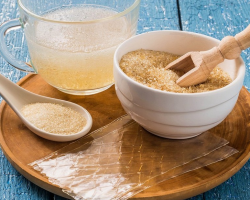This article describes acids used by manufacturers in cosmetics. You will learn how they work - a description.
Content
- What role of acid is played in face cosmetics?
- Hyaluronic acid in face cosmetics: Korean cosmetics, serum Librider, DNC
- Cosmetics for the face with azelainic acid: component in the cream for cleansing
- Fatty acids in alpha cosmetics for the face: good care
- Ferulic acid as part of cosmetics, peeling: the best antioxidant for face care
- Aha acids: Aha cosmetics for the face with milk, lemon, glycol, almond, apple, wine component
- BHA acids in face cosmetics: salicylic acid
- Cosmetics for face care with fruit acids: what effect does a “delicious” component have?
- Stearic acid in cosmetics: fat -soluble acid -based cosmetics
- Amber acid in cosmetics: Description
- Alpha-lipoic acid in cosmetics: alpha acid useful for the skin
- Ascorbic acid in cosmetics: creams for skin elasticity
- Benzoic acid in cosmetics: application
- Miristic acid in cosmetics: application
- Palmitic acid: a description of professional cosmetics with acids
- Nicotinic acid: cosmetics with acids for problem skin
- Russian, Belarusian, foreign cosmetics with acids: reviews
- Video: face acids. What transforms the skin
The word "acid" is often associated with something destructive. Before the eyes, experiments from chemistry or test tubes immediately arise, in which caustic green liquid gurgles. However, in the care of the skin, acids play the role of a “good policeman”, they are successfully used in the fight against various skin problems. How are various types of acids useful? Read further.
What role of acid is played in face cosmetics?

Facial cosmetics with acids are usually understood as a means with exfoliating and renewing effects. Products with AHA-, BHA- and PHA acids play a huge role in cosmetics. They help get rid of such flaws of the upper layer of the epidermis:
- Inflammation on the skin
- Various manifestations of acne
- Keratinized skin
- Wrinkles
- Pigmentation
- Uneven relief and others
In beauty products, you can find different types of acids. All of them are useful and help us acquire smooth and even skin. What kind of acids are these and what exactly they are used, read on.
Hyaluronic acid in face cosmetics: Korean cosmetics, serum Librider, DNC

Hyaluronic acid is a popular component of moisturizing and anti -aging products. In general, it is present in our body and is an important element of connective tissue, participating in many biological processes.
It is worth knowing: The molecules of this polysaccharide are able to attract and maintain a mass of water, which significantly exceeds their own.
Therefore, the "hyaluron" in the composition of cosmetics perfectly moisturizes the skin of the face and helps to smooth out small wrinkles. Thanks to these properties, such acid is used in injection cosmetology. As part of Korean and Russian cosmetics, for example, in creams, masks, serums and lotions Librider, you can find hyaluronic acid.
Cosmetics for the face with azelainic acid: component in the cream for cleansing
Azelain acid is extracted from cereals. It has an antioxidant, anti -inflammatory and antibacterial effect. Face cosmetics with this component are used to care for the skin with acne and rosacea. Also used in the treatment of hyperpigmentation, in particular post -acne. It has almost every cream or lotion.
Fatty acids in alpha cosmetics for the face: good care

Fatty acids are an important building material of cell membranes. Means with such components (linoleic, alpha-linole, oleic acids) positively affect dry and irritated skin:
- Strengthen the lipid barrier of the skin
- Remove discomfort
- Protect against the negative effects of the external environment
A good care alpha cosmetics for the face always contains fatty acids. Here are manufacturers who use such components in their cosmetics:
- Mizon
- Tony Moly
- Lador
- Iherb
These are creams, lotions and all manufacturers add it to their own products to create effective face and body cosmetics.
Ferulic acid as part of cosmetics, peeling: the best antioxidant for face care
Ferulic acid - Antioxidant of plant origin. Makes the skin more resistant to oxidative stress (cell damage due to oxidation). Helps to deal with such signs of photo starting as hyperpigmentation. Typically, feralic acid can be found in serums. Often - as part with vitamins FROM and Ethat she stabilizes. For example, in peeling Bielita, Biomatrix, Iherb and others.
Aha acids: Aha cosmetics for the face with milk, lemon, glycol, almond, apple, wine component

Alfa-hydroxy acids are perhaps the most popular acids of a wide spectrum of action. Aha acids include such acids:
- Glycole
- Milk
- Almond
- Apple
- Wine
- Lemon
All these components have an exfoliating effect. Aha acids water-soluble: they cannot penetrate deep into the skin and act at the level of the epidermis. It is noteworthy that in low concentrations ( up to 4%) Alfa-hydroxy acids are able to retain moisture in the skin, so they are added to moisturizing agents. It is also worth noting the following:
- Lactic acid The action is almost identical to the glycol. It exfoliates and moisturizes the skin, and also helps to return it to a healthy color - however, given the larger size of the molecules, it makes it slower. This acid is contained in dairy products, but for the production of cosmetics it is often synthesized artificially in laboratories.
- Apple acid -Alfa-hydroxy acids with antioxidant properties. It is a weak exfoliant, but works well in combination with milk and glycolic acids.
- Almond acid With its large molecules, it penetrates the skin more slowly than other AHA acids. This makes cosmetics with almond acid acceptable for sensitive skin.
- Citric acidGiven its irritating effect, they are almost not used for the purpose of exfoliation.
To make the skin healthy and have a fresh look, it must constantly be updated. If many keratinizing (dead) cells accumulate on its surface, the relief becomes uneven, and the color becomes dull. Overloaded skin with clogged pores is more prone to the formation of inflammation and black dots. It misses the ingredients of cosmetics worse, so serums, creams and masks that you use are less efficient. Exfoliation helps to accelerate the processes of skin regeneration, which is mechanical and chemical.
- Mechanical exfoliation It provides for exfoliation of the skin with the help of scrubs, special cleansing brushes, peeling slopes of the like.
- Chemical exfoliants Based on acids, they help get rid of excess without mechanical exposure. They disconnect the connections between keratinized cells and gently remove them. As a result, the skin becomes brighter, flat and shining.
Safe concentration Aha acid In home care - to 10%. The use of a high content of acids is possible only under the supervision of a specialist.
BHA acids in face cosmetics: salicylic acid

Several types of beta-hydroflines are known to science, but when they talk about cosmetics, they mean only one salicylic. It is she who is actively used in the beauty industry. Unlike Aha acid, BHA components It is dissolved not with water, but with fat, so it is able not only to exfoliate the cells on the surface of the skin, but also to penetrate deep into the pores and act at the dermis level.
It is worth knowing: Studies show that with proper dosage, salicylic acid can be used even with rosacea.
The optimal concentration of salicylic acid in the face cosmetics and other home care products - 0,5-2%. Such cosmetics are represented by well -known manufacturers:
- Norva
- Clarins
- Vishi Total Mat
- La Rosh Poz
- Klinks Mat
- Exfoliating Lotion
Meet BHA acid It is possible both in lotions, serums and cleaning agents, and in local products aimed at the express production of individual inflammations.
Cosmetics for face care with fruit acids: what effect does a “delicious” component have?

Mass production of cosmetics with fruit acids began in the 90s of the last century. Such acids are popular components of many cosmetics. Fruit acid in cosmetics for face care, which falls on the skin, connects calcium ions and breaks intercellular bonds. What is this “delicious” component? Answer:
- The skin devoid of calcium ions is freed from old cells, they freely exfoliate from its surface.
- Fruitic acids help retain moisture in the epidermis.
Such a component, which is part of cosmetic drugs - both special purposes and wide consumption - are noted on the packaging by the abbreviation Aha.
Stearic acid in cosmetics: fat -soluble acid -based cosmetics
Stearinic acid is often found in nature. It was first allocated from pork fat, but it is contained in natural form and in other fats. In laboratory conditions, stearic acid is a powder with the smell of wax. It does not dissolve at all in water, but in oil or fat it disappears without a trace.
Stearinic acid has a mass of beneficial properties. It is present in any cosmetics. Fatty cosmetics based on a compulsory component - stearic acid - these are such decorative and other means:
- Soap
- Lipstick
- Decorative cosmetics
- Conducting creams and balms
In cosmetology, stearic acid is used to give a density of the initial mixture of components.
Amber acid in cosmetics: Description

Recently, a high-active substance has appeared in the beauty services market-amber acid. Here's a description:
- Molecules of this substance are able to distinguish healthy cells from patients and direct their influence on them.
- Salts of amber acid easily penetrate under the skin, independently detect foci of inflammation or unhealthy pigmentation and are included in the work.
Quite often, amber acid can be found as part of cosmetics of various brands. This substance is widely used by brand manufacturers:
- Alpika
- Refharm
- Medical collagen
The market quickly responds to the desire of fashionistas to preserve a youthful look.
Alpha-lipoic acid in cosmetics: alpha acid useful for the skin
Alpha-lipoic acid It has a lot of useful properties, but its most outstanding ability is to prevent aging. It is known that over time, collagen fibers glue with glucose, so tissue nutrition worsens, deformations appear.
The alpha acid useful for the skin is most often present in the line of foods that have an anti-aging effect. This includes a series of brands:
- Dermma E
- Reviva Labs
- Holy Land
- Aroma Naturals
Alpha-lipoic acid It prevents the accumulation of glucose in cells, does not allow collagen to destroy. Moreover, it launches a reparative mechanism and eliminates the damage caused to collagen.
Ascorbic acid in cosmetics: creams for skin elasticity

Ascorbic acid takes an active part in the synthesis of collagen, therefore it is responsible for maintaining the elasticity of the skin. This vitamin enters the body with food, but the skin does not always receive the necessary dose of ascorbic acid.
- In case of chronic deficiency of vitamins, which is observed in most inhabitants of the planet, the probability of insufficient supply of the skin ascorbic acid is maintained at a high level.
- Fortunately, the intake of vitamin outside has a beneficial effect on the skin.
- Therefore, it is possible to fight wilting and hyperpigmentation with cosmetics - creams and other means for skin elasticity.
Due to the powerful anti -aging effect, ascorbic acid is included in the composition of anti -aging creams. Vitamin C - Mandatory ingredient in products of famous brands:
- VICHY
- Lancome
- La Roche-Posay
- Garnier
Such cosmetics are very popular among women. It rejuvenates the skin, smoothes wrinkles and removes different defects.
Benzoic acid in cosmetics: application
As a rule, any cosmetics contains preservative substances. All manufacturers add benzoic acid to their goods to slow down the growth of bacteria and extend the service life of a cosmetic agent. However, it is worth knowing about the use of this substance as follows:
- Benzoic acid has not only preservative properties.
- In means for problem skin, this substance also performs caring functions.
- In addition, benzoic acid can be found in drugs for the information of freckles and age spots.
Unfortunately, some people are sensitive to preservatives, and contact with benzoic acid causes them a skin allergic reaction.
Miristic acid in cosmetics: application

Miristic acid is contained in many natural oils. In a small amount, it is present even in the subcutaneous fat layer of a person. Cosmetologists include this substance in the composition of nutrient mixtures, since myristic acid contributes to better penetration into the deep layers of the skin of the remaining ingredients.
In addition, such cosmetics have protective and restoring properties. Here are a few more nuances of application:
- When applied to the skin, it has a lubricant.
- It is used as an emulsing component in creams and fences.
Miristic acid is often found in cosmetics of many brands:
- Eveline
- Kanebo
- Nivea
- Luxvisage
This component is used for the production of mascara for eyelashes that cleanse the emulsion.
Palmitic acid: a description of professional cosmetics with acids

Palmitic acid is a product that is often found in nature. It is part of almost all existing fats and oils. The stingy layer of the skin contains a significant supply of palmitic acid. Here is a description of professional cosmetics with such acids:
- Over the years, the concentration of palmitic acid in the skin layer decreases.
- Therefore, oils with this substance are recommended to be used for caring skin.
- Cosmetologists use palmitic acid as a thickener.
- In addition, it has a beneficial effect on hair: nourishes, protects, returns the original structure.
Palmitic acid is present in the list of ingredients for many manufacturers of cosmetics:
- Givenchy
- Liano
- VICHY
- Darphin, Benefit
This component is used in the production of soap, shampoos, lipsticks, creams.
Nicotinic acid: cosmetics with acids for problem skin

Nicotinic acid or vitamin B3 - An important connection involved in many metabolic processes. It has a powerful effect on the skin:
- Stimulates the formation of collagen
- Narrows the pores
- White
- Relieves from acne
Given the wide range of positive effects, nicotinic acid is often included in the cosmetics of various categories:
- Rejuvenating
- Sunscreen
- Moisturizing
- For problem skin
Vitamin B3 Contained in home care products for well -known manufacturers:
- La Roche-Posay
- Corave
- VICHY
- Garnier
Cosmetics with acids are drugs that give the skin a radiant look that relieve inflamed acne and excessive pigmentation. They help to smooth the wrinkles and tighten the oval of the face.
Russian, Belarusian, foreign cosmetics with acids: reviews

Acids carefully scrape away the keratinized layer from the surface of the skin and accelerate the process of renewing the dermis. Each of the acids contained in the product has its own purpose. Preparations with acid are always used with a specific purpose. All of them are good to cope with certain problems on the skin. Here are the reviews of other people about Russian, Belarusian and foreign cosmetics with acids:
Christina, 23 years old
I like to use Belarusian cosmetics with acids. Acne disappears after it, and the skin becomes smooth and beautiful. My friends also love cosmetics from Belarus. One of them is a blogger, and recently she made an overview of her funds that she uses.
Anastasia, 27 years old
I adore the federal peeling. He perfectly removes hyperpigmentation, exfoliates and treats the skin, removing irregularities and pimples. Ferulic acid is part of many of my creams. I always advise you to use just such cosmetics. Try it, you will see the result after the first application.
Polina, 25 years old
I have combined facial skin. Therefore, all the time I carefully select cosmetics to fit. Creams with acids perfectly remove pigmentation after acne. A pair of procedures is enough, and the face becomes clean. I do care at home, independently. Fortunately, now there is a lot of high -quality cosmetics that helps to cope with different problems, which does not even need to make great efforts.
Video: face acids. What transforms the skin
Read on the topic:







